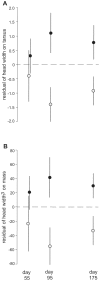Getting a head start: diet, sub-adult growth, and associative learning in a seed-eating passerine
- PMID: 21949684
- PMCID: PMC3176201
- DOI: 10.1371/journal.pone.0023775
Getting a head start: diet, sub-adult growth, and associative learning in a seed-eating passerine
Abstract
Developmental stress, and individual variation in response to it, can have important fitness consequences. Here we investigated the consequences of variable dietary protein on the duration of growth and associative learning abilities of zebra finches, Taeniopygia guttata, which are obligate graminivores. The high-protein conditions that zebra finches would experience in nature when half-ripe seed is available were mimicked by the use of egg protein to supplement mature seed, which is low in protein content. Growth rates and relative body proportions of males reared either on a low-protein diet (mature seed only) or a high-protein diet (seed plus egg) were determined from body size traits (mass, head width, and tarsus) measured at three developmental stages. Birds reared on the high-protein diet were larger in all size traits at all ages, but growth rates of size traits showed no treatment effects. Relative head size of birds reared on the two diets differed from age day 95 onward, with high-diet birds having larger heads in proportion to both tarsus length and body mass. High-diet birds mastered an associative learning task in fewer bouts than those reared on the low-protein diet. In both diet treatments, amount of sub-adult head growth varied directly, and sub-adult mass change varied inversely, with performance on the learning task. Results indicate that small differences in head growth during the sub-adult period can be associated with substantial differences in adult cognitive performance. Contrary to a previous report, we found no evidence for growth compensation among birds on the low-protein diet. These results have implications for the study of vertebrate cognition, developmental stress, and growth compensation.
Conflict of interest statement
Figures





References
-
- West-Eberhard MJ. New York: Oxford University Press; 2003. Developmental plasticity and evolution.794
-
- Mousseau TA, Fox CW, editors. New York: Oxford University Press; 1998. Maternal effects as adaptations.375
-
- Lindstrom J. Early development and fitness in birds and mammals. Trends Ecol Evol. 1999;14:343–348. - PubMed
-
- van Buskirk J, Steiner UK. The fitness costs of developmental canalization and plasticity. J Evol Biol. 2009;22:852–860. - PubMed

